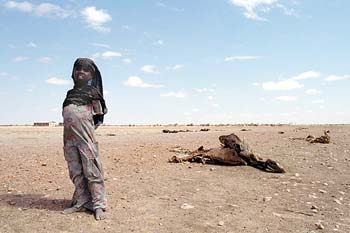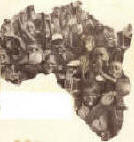Hunger in
southern Africa
Can famine be averted?
The Economist
August 1, 2002
If food aid is slow or
obstructed, there will be starvation
|
AFRICA'S hunger is growing, dangerously. However quickly donors respond to
the disastrous food shortage in southern Africa, millions more people will
need aid over the next nine months.
Stocks from April's awful harvest are nearly exhausted. The World Food
Programme (WFP) says that 7m people already need
help, and that the numbers will double before Christmas. In the
worst-affected countries, Zambia, Zimbabwe and Malawi, maize harvests were
miserable, but cassava and potatoes partly filled the gap. Now these are
almost gone, too. Within months, say aid agencies, chronic hunger could give
way to starvation in the most remote areas. If donors are slow or
obstructed, a vaster famine looms. |
 |
Rural
people are vulnerable even in normal times. Malawi's woes are typical: it has a
shrinking economy and endemic poverty; half its children are chronically
malnourished. An acute land shortage has led to over-use, soil degradation and
small yields. Imported fertiliser could make even tiny plots productive, but
most small farmers cannot afford to buy it, and donors are sending less of it
free. An internal report written in July by Britain's Department for
International Development admits that its own severe cut in “free inputs” for
Malawi's farmers in 2000 and 2001 was a “more important factor” leading to
hunger than two years of bad weather.
The
meagre harvests that resulted meant that the vulnerable have become desperate.
In Ositeni, a village in central Malawi, a few withered maize stalks and
yellowing cassava plants poke up from the dusty soil. The village has no
irrigation, no grain silos, and no tomatoes or cash crops to trade for nsima,
the country's maize staple. In other years, able adults would find casual work
on neighbours' fields, in exchange for food. Now there are no jobs.
Last
week, the first sacks of charitable corn were unloaded for Ositeni's 13 most
needy families. But stockpiles are needed before November's rains make the
bare-earth roads impassably muddy. The WFP has appealed
for $507m for southern Africa, but has so far raised less than a quarter of
that. Last week, relief groups and the Red Cross launched their own campaigns,
and a few million dollars have rolled in. It is already getting late, says
Brendan Paddy of Save the Children: “During the region's 1991-92 shortage, food
was already stockpiled in forward positions by now. We are three or four months
behind.” Aid workers fear that donors will not respond until they see skeletal
people on television.
Zimbabwe's way
Even a
generous response could be hampered. In Zimbabwe, where 6m people will need
help, the government has ordered hundreds of commercial farms to close down by
August 10th and is deliberately starving communities suspected of supporting the
opposition. In Binga, a western district, 115 tonnes of high-protein porridge,
intended to feed local schoolchildren, lies unused and rotting in a warehouse. A
band of Mr Mugabe's club-wielding militiamen refuse to allow it to be
distributed, because 85% of the people of Binga voted for Mr Mugabe's opponent,
Morgan Tsvangirai, at the presidential election in March. The police could
easily disperse them, but do not. Already, the children of Binga are fainting
from hunger in class, and 27 people have died of hunger-related causes in the
local hospital.
In other
Zimbabwean areas, peasants suspected of dissent are barred from buying maize
from the state marketing board. All around the country, the government seizes
grain from “hoarders” and sells it cheaply to ruling-party card-holders. The
regime barely troubles to hide its malign intentions: a deputy foreign minister
recently crowed that “the [ruling] party will start feeding its children before
turning to those of the [opposition].” James Morris, head of the
WFP, says his agency will leave Zimbabwe “in a second” if its donations
of food are manipulated for political ends. But the WFP
has failed to prevent such misuse in the past in Sudan, Somalia, Angola and
elsewhere.
The
leaders of Zambia and Malawi are less obstructive, but their countries are far
from ocean ports and have narrow roads and poor train tracks. Malawi's
government is also under fire for selling all the grain (more than 160,000
tonnes) in its national store two years ago. In the capital, Lilongwe, diplomats
and aid workers say that people close to the ruling party profited from the
grain sale. “In another country they would be on trial by now,” says one
diplomat.
Last week
South Africa's president, Thabo Mbeki, admitted that the threat of 14m hungry
people by the end of the year did not warrant discussion at the inaugural
meeting of the African Union, which he chaired in July. But the danger stretches
beyond this year. Aid workers worry that another bad harvest is likely in 2003,
whatever the weather.
Poor
soil, lack of fertiliser and the loss both of livestock and of people threaten
production. The weakening effect of hunger means that more people are dying from
diseases such as AIDS, which infects roughly a fifth of
the people in Zambia, Zimbabwe and Malawi. The ravages of AIDS,
plus the worsening poverty, mean that recovering from this food shortage
will be tougher than it was after previous ones—and that people will be even
weaker and more vulnerable when the next spell of deadly hunger arrives.
* *
* * *
Below
is another article from The Economist
which discusses starvation in Africa. This article is about Ethiopia and
the role that warfare has played in its current food shortage and pending
famine. This article, like the one above, reinforces the point that
political factors, not overpopulation, are primarily responsible for famine and
malnutrition in Africa.
|
Famine in Ethiopia
Drought, death
and taxes
The Economist
September 5, 2002
|

Six
million Ethiopians are going hungry.
The weather, and a war, are to blame
|
A GREAT
lake stretches across the desert, shimmering enticingly. Unfortunately, it is a
mirage. The Afar region of Ethiopia, perhaps the hottest inhabited place on
earth, is even drier than usual this year, and the people who live there have
run out of food. Their beloved cows lie dead and dying in the hot sand. Many of
the carcasses are so fresh that the storks and hyenas have not yet had time to
peck or chew them clean.
In much
of eastern, southern and northern Ethiopia, the rains have been rotten this
year. In all, 5.9m of Ethiopia's 65m people need food aid or other assistance,
according to the World Food Programme. The food shortage is not as terrible as
the one in southern Africa. Nor is it as disastrous as the famine Ethiopia
suffered in the mid-1980s. Ethiopia's current government is not indifferent to
human suffering in the way its old Marxist dictatorship was, or Zimbabwe's
government now is.
Nonetheless the situation is grim. Among the worst affected are the Afars, a
tough, gun-toting people who subsist by herding livestock in the arid vastness
of north-eastern Ethiopia. The Afars are almost all poor, but like most
pastoralists, they have developed sophisticated methods for avoiding starvation.
Their only assets are their animals, but they diversify their portfolios, so to
speak, by breeding cows, goats, camels and sheep. Cows are a high-risk,
high-yield investment. They breed fast and produce lots of milk, but they are
the first beasts to die in a drought. Goats are scrawnier, but hardier. Camels
are the toughest of all, but breed slowly. Afars have insurance, too, in their
kinship ties. In hard times, those with spare livestock share with those who
have not.
Despite
all these precautions, Afars are often malnourished. Their nomadic traditions
fiercely discourage them from settling down, but many have grown desperate
enough to start rearing maize as well as cows and camels. Most years, these
“agro-pastoralists” have enough to eat, but this year even they are suffering.
“All our
cows died, and the ground is too dry to grow maize,” says Muhammad Oumar, a
skinny father of four, squatting in the dust by a treeful of yellow orioles.
Hunger has not yet turned to starvation in his village; the villagers hike 20km
(12 miles) to Assaita, the nearest town, to sell woven mats or firewood and buy
flour. But there is not enough to go around, and malnutrition has made many
vulnerable to disease.
Children
have no milk, and must make do instead with a thin porridge made from teff, an
indigenous grain. The 15 households in Mr Oumar's village look after 20 orphans
between them. In another nearby village of 100 homes, 13 people have perished in
the past month, according to Muhammad Hassan, a peasant with sunken, cavernous
cheeks. “We need food,” he says, “or we're going to die.”
The
immediate cause of Ethiopia's food crisis is the weather. But political factors
play a role, too. After Ethiopians shook off their Marxist overlords in 1991,
food production rose steadily. But between 1998 and 2000, a pointless war with
neighbouring Eritrea stymied progress.
Strong
young men were summoned from their fields and sent to the front line. Tens of
thousands of people were killed, and perhaps 350,000 forced to flee their homes.
Families with members on both sides of the border were separated. Flour mills,
bridges, power lines and irrigation systems were destroyed. Most aid was frozen.
In all, the war cost Ethiopia $2.9 billion, according to the Ethiopian Economic
Policy Research Institute, a private think-tank. That is almost a whole year's
output for every farmer in Ethiopia; and more than 80% of the population live on
farms.
Wanted:
rain, aid and tax cuts
Another
problem, strangely, is tax. Ethiopia abandoned feudalism in the 1970s, when the
emperor, Haile Selassie, was murdered, but the old feudal habit of taxing
peasants persists. The most irksome levy is payable on the land that peasants
till, which they are not allowed to own, because the government owns all the
land. The sums involved are small, but do not seem so to those who pay them. Mr
Oumar usually hands over 60 birr ($7) a year, which he describes as “heavy”. The
average Ethiopian income is only $100 a year, but most peasants earn far less.
Tax-collectors generally make an exception for those who are on the verge of
starving: this year, Mr Oumar was let off. They tend not to tax nomads either,
partly because they are hard to trace, and partly because so many carry
submachineguns. But taxes levied on peasants in years when the harvest is good
make it hard for them to accumulate a surplus to see them through the bad years.
What is
more, taxes must be paid in cash, shortly after harvest time. To raise this
cash, peasants all take their spare crops to market at the same time, which
depresses prices and means they have to sell more of their crop to meet their
tax bill. The tax raises negligible sums for the government (only 1% of total
annual revenues), but inflicts serious harm on the most vulnerable Ethiopians.
“If we don't pay,” laments Mr Oumar, “they say they'll take our land.”
* *
* * *

Population Syllabus



